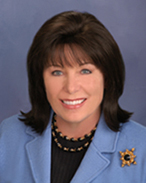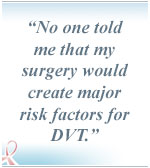
"DVT Awareness Needs to Catch Up With Breast Cancer Awareness"
As a survivor of both Deep-Vein Thrombosis (DVT) and breast cancer, I’m struck by
the huge gulf between the awareness levels of these diseases. Nearly every woman
in this country knows the importance of detecting breast cancer early through mammograms
and self-exams. Yet, so few people are familiar with the symptoms of DVT and on
the lookout for them – including cancer patients, who are at increased risk for
this condition.
Sharing my story
I developed DVT just six months after David Bloom’s death launched the condition
into the national headlines. Like many people who heard his story, I was saddened
but didn’t think DVT was something I needed to worry about. Later, after I experienced
its effects, I felt like I was one of the few people who realized how common and
how deadly this condition is. When I discovered the Coalition to Prevent DVT Web
site, I read other people’s stories and knew I wasn’t alone. I was inspired to share
my own story in the hope that it would prevent someone else from suffering. Even
if my story helps just one individual, it will make my heart sing.

Major risk factors
In September 2003, after being diagnosed with breast cancer, I underwent a mastectomy
and reconstructive surgery. The surgery included my abdominal area, took eight hours
and left me immobilized for six days. No one told me that these were major risk
factors for DVT.
While still in the hospital, I was given a breathing test. It showed I couldn’t
breathe well and caused me pain, but the staff didn’t take these results seriously.
They saw me as someone who simply couldn’t handle discomfort and dismissed my complaints.
An unlucky trifecta
I went home and experienced no further symptoms until a week after the surgery,
when I had my surgical drains taken out. That night, I developed chest pains and
had difficulty breathing. My worried husband stayed up all night watching me and
feeling helpless. Neither of us understood why I was in pain and couldn’t breathe.
I had never had surgery before. Maybe all the work the surgeons had done on my upper
body was somehow responsible?
We got the answer when we went back to the hospital, where the young doctor who
examined me in the emergency room recognized the possibility that I might have complications
from DVT. In fact, it turned out that I had the "trifecta" of surgical complications
– DVT, pulmonary embolism and infection.
Although I suffered considerably before my symptoms were correctly identified, I
was lucky in some ways. First, my DVT and PE were caught in time. Second, my husband
is CEO of two hospitals, so I had access to a top pulmonologist who treated my condition
effectively once we knew what we were up against.
A life touched by DVT
Facing DVT has changed the way I live in many ways. Before my three subsequent surgeries,
I went to a hematologist, who prescribed a blood-thinning agent as a precaution.
My surgeon was equally cautious, insisting that I take two venous doppler tests
– ultrasounds that show if there is any blockage in the veins of the legs – 90 days
apart, with all-clear results, before he would perform surgery. I also took a blood
thinner after the procedures.
Most important, I’ve become passionate about communicating the risk of DVT to everyone
I meet. Everyone needs to know the facts and how to help themselves, especially if they or their loved ones are scheduled for surgery.
Today I’m strong, healthy and feeling like a different person than I did when my
DVT was diagnosed. On the day I was readmitted to the hospital with DVT, PE and
pneumonia, I was so sick I couldn’t even walk to the bathroom. Exactly one year
later, I walked 60 miles over three days in the Susan G. Komen Breast Cancer Foundation
Race for the Cure. It was the perfect way to celebrate surviving not only breast
cancer but also DVT – the kind of victory I wish for everyone who faces cancer.